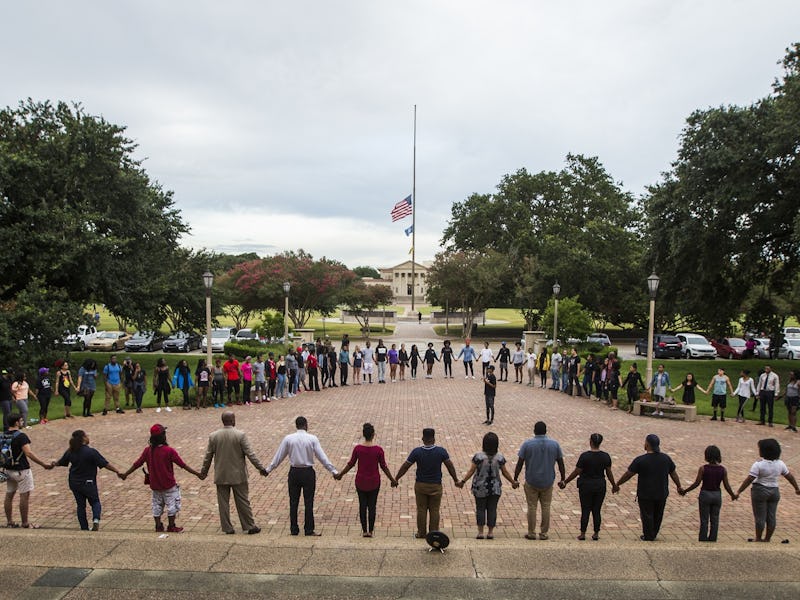Violent Videos on Your Newsfeed Can Spur Action — and Apathy
To share or not to share? That is the question.

The internet was a particularly sad and hurting place last week. On July 5, police shot and killed Alton Sterling at point-blank range while they had him pinned to the ground. The next day, on July 6, a police officer shot and killed Philando Castile at a traffic stop, in view of his girlfriend and her 4-year-old daughter. On July 7, a shooter opened fire at a protest related to both previous events, killing five police officers and injuring many more.
Each of these events was caught on video and shared widely across social media. And for the majority of us, watching as these events unfolded from places that seemed far away and yet were so close, the violence has never felt so intimate, so personal.
What happens to us when we scroll past atrocities daily on our newsfeeds? Do they serve as a call to action to build a better world, or do they cause us to look away? The answer might be both, says Brad Bushman, who has studied the consequences of exposure to media violence for several decades. For Black Lives Matter activists, video evidence of police aggression against black people is both documentation and impetus for change. “When people are angry they want to act,” he tells Inverse. “That’s what fueled the civil rights movement, the women’s suffrage movement, Black Lives movement — all of it is fueled by anger.”
So, exposure to violence can fuel anger, and anger can fuel positive social change. But violent videos might also stoke the anger of your opponents, too, says Bushman. “My guess is that these videos are going to make everybody angry, but for different reasons. People who are sympathetic to the movement will become angry at how black lives seem to matter less than white lives in America, and people who are not sympathetic, it will make them angry too, that the movement according to them is leading to more violence against police officers.”
Police officers arrive at an interfaith memorial service, honoring five slain police officers, at the Morton H. Meyerson Symphony Center on July 12, 2016 in Dallas, Texas.
Here’s the twist: Using rage to push for action has the ironic consequence of making you less sensitive. The more graphic violence you see, the less you react to it. Bushman and colleagues conducted a study published in 2009 where participants played 20 minutes of either violent or non-violent video games. Afterwards, while completing a questionnaire, they heard a (staged) loud fight in which someone was hurt outside the window. Those who played the violent game responded less quickly to what they thought were real cries for help. It’s not just fake video game violence that has this desensitizing effect, says Bushman — research elsewhere has shown that people are more numbed when they are exposed to actual violence. In other words, grisly war footage might desensitize you to a crime happening in front of your face: It’s more urgent, but the scale-back in intensity might make you shrug and walk past.
It’s a depressing sort of catch-22. Spreading awareness of injustice is a precursor to change, but it can also spur division, retaliatory violence, and apathy. Facebook clarified its policies for sharing graphic content last week, after the live video of the aftermath of the shooting of Philando Castile was briefly removed from the site, and then re-added with a content warning. “Context and degree are everything,” according to the news release. “For instance, if a person witnessed a shooting, and used Facebook Live to raise awareness or find the shooter, we would allow it. However, if someone shared the same video to mock the victim or celebrate the shooting, we would remove the video.”
Using content warnings to give users a say over if and when they consume media showing real, graphic violence seems like a sensible approach. It’s not necessary to watch Alton Sterling, Philando Castile, and the police officers in Dallas die on camera in order to feel enraged by their deaths, and feel motivated to try to build a better future.
This week in the New Yorker, Jill Lepore wonders if “watching people shoot one another has become an obligation of American citizenship.” She had avoided the videos, though ultimately decided to watch. “I’d been sitting at the breakfast table, crying, like so many people, while reading the news about the sniper in Dallas who shot twelve police officers, killing five of them, and had decided not to watch any of the footage of what happened that night for the same reason I’d decided not to watch any of the videos earlier in the week: watching had, oh, three or four murders ago, begun to feel like a kind of complicity, as if we’re all prisoners marched out of our cells and into the prison yard to serve as spectators for the next execution: the gun fires; we flinch; we return, helplessly, to our cells.”
The act of documenting horrible events will not make them go away, as Lepore points out. The world of the future may not become more violent, but it’s probably going to feel that way. Those who wish to spread hatred and fear — like the ISIS operatives who make videos of themselves beheading Americans — will exploit our attention and our inclination to share. And it might not be our moral obligation to bear witness to every act of violence, but to confront injustice thoughtfully and sensitively.